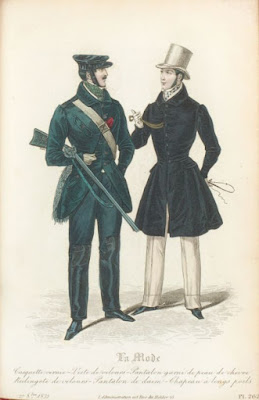Here we have an engraving of a couple of fashionable, very Victorian, outfits. The wearers are swathed in yards of expensive and heavily ornamented fabrics, and are covered almost entirely except for their faces. It's clear that they can neither work nor exercise in such garments. Their main function appears to be showing of their (husbands') wealth!
Ironically, it was the Industrial Revolution that made such retrograde fashions possible. Mechanisation meant that fabrics could be produced in more abundance than ever before, and the mass production of hoop skirts meant that they could be sold cheaply and move from the salon to the streets in record time. Our two well-to-do ladies would have work to do to keep ahead of the hoi polloi. At this stage that meant wearing more of the most expensive fabrics, and hiding them beneath layers of labour-intensive decoration.
Two more important technological innovations took place in 1856. The first was the invention of the first aniline dye, and the second was the formation of the Singer Sewing Machine Combination. Fashion would become louder, faster, and more excessive in future decades.
TOILETTES DE VILLE
Chapeau orné de trois plumes sur la passe.—Robe de taffetas à deux jupes ornée d'une greque formée par trois velours. Sur le corsage, une berthe ornée comme les jupes. Manches formées par un gros bouillonné d'étoff, terminées par un large pagode. Cols et manches en dentelles.
Chepeau en étoff et blonde orné de deaux plumes sur la passe, et un large nœd dont les bouts retombent sur le bavolet. — Basquine en velours garnie le haute dentelle.— Robe en taffetas à trois volants et dispositions de velours. — Col, manchettes et mouchoir, en guipure.
[TOWN COSTUMES
Hat decorated with three feathers on the side. — Taffeta dress with two skirts decorated with a Greek key pattern made in three velvets. On the bodice, a berthe decorated like the skirts. Sleeves formed by a large bubble of fabric, ending in a large pagoda. Lace collars and undersleeves.
Hat in fabric and blonde decorated with two feathers and a large bow whose ends fall on the flap. — Velvet basquine trimmed with fashionable lace. — Taffeta dress with three ruffles and velvet arrangements. — Collars, cuffs and handkerchief, in guipure.]
























